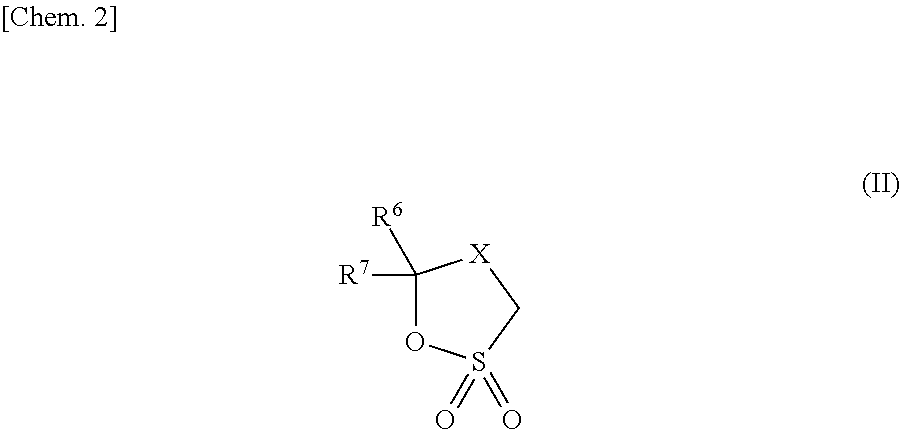Non-aqueous electrolyte and power storage device using same
a technology of non-aqueous electrolyte and power storage device, which is applied in the direction of non-aqueous electrolyte cells, cell components, electrochemical generators, etc., can solve the problems of easy deformation, poor battery characteristics, and very likely influence of deformation on electronic devices, so as to improve the capacity retention rate and reduce the rate of electrode thickness increase
- Summary
- Abstract
- Description
- Claims
- Application Information
AI Technical Summary
Benefits of technology
Problems solved by technology
Method used
Image
Examples
examples i-1 to i-23
and Comparative Examples I-1 to I-3
[Production of Lithium Ion Secondary Battery]
[0118]94% by mass of LiCoO2 and 3% by mass of acetylene black (electroconductive agent) were mixed and then added to and mixed with a solution which had been prepared by dissolving 3% by mass of polyvinylidene fluoride (binder) in 1-methyl-2-pyrrolidone in advance, thereby preparing a positive electrode mixture paste. This positive electrode mixture paste was applied onto one surface of an aluminum foil (collector), dried, and treated under pressure, followed by punching out in a prescribed size, thereby producing a positive electrode sheet. A density of a portion of the positive electrode except for the collector was 3.6 g / cm3.
[0119]95% by mass of artificial graphite (d002=0. 335 nm, negative electrode active material) was added to and mixed with a solution which had been prepared by dissolving 5% by mass of polyvinylidene fluoride (binder) in 1-methyl-2-pyrrolidone in advance, thereby preparing a negat...
examples iii-1 to iii-8
[Production of Lithium Ion Secondary Battery]
[0156]A positive electrode sheet and a negative electrode sheet were produced in the same manner as in Example I-1; the positive electrode sheet, a micro-porous polyethylene film-made separator, and the negative electrode sheet were laminated in this order; and a nonaqueous electrolytic solution having a composition shown in Table 8 was added thereto, thereby producing a laminate-type battery.
[0157]A high-temperature cycle property was evaluated in the same manner as in Example I-1.
[0158]Production conditions of battery and battery characteristics are shown in Table 8.
TABLE 8AdditionIncreaseamount ofAdditionrate inComposition of1,3-dioxaneamountDischargenegativeelectrolyte salt(content in(content incapacityelectrodeComposition ofnonaqueousCompound to benonaqueousretentionthicknessnonaqueous electrolyticelectrolyticused inelectrolyticrate afterafter 100solutionsolution)combination withsolution)100 cyclescycles at(Volume ratio of solvent)(%...
PUM
| Property | Measurement | Unit |
|---|---|---|
| electropositive voltage | aaaaa | aaaaa |
| temperature | aaaaa | aaaaa |
| density | aaaaa | aaaaa |
Abstract
Description
Claims
Application Information
 Login to View More
Login to View More - R&D
- Intellectual Property
- Life Sciences
- Materials
- Tech Scout
- Unparalleled Data Quality
- Higher Quality Content
- 60% Fewer Hallucinations
Browse by: Latest US Patents, China's latest patents, Technical Efficacy Thesaurus, Application Domain, Technology Topic, Popular Technical Reports.
© 2025 PatSnap. All rights reserved.Legal|Privacy policy|Modern Slavery Act Transparency Statement|Sitemap|About US| Contact US: help@patsnap.com



